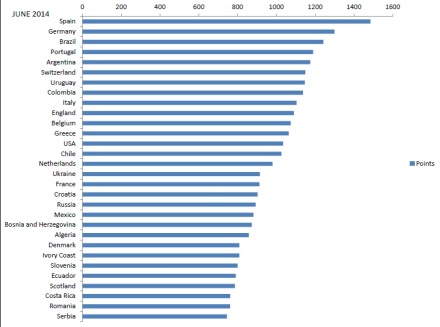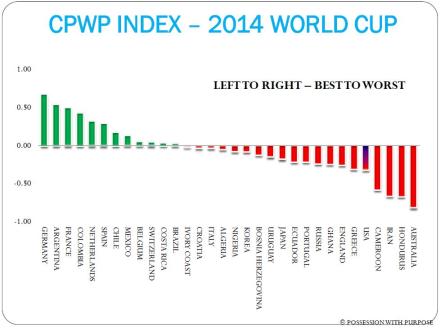FIFA is embroiled in a huge scandal and the time couldn’t be better to review and consider new ways to rank National teams across the World.
There are two parts to this for your consideration.
- Details on how the FIFA World Cup Power Rankings occur and my own thoughts on how they are calculated, and
- My own FIFA Possession with Purpose Power Rankings and my closing thoughts on the effort as a whole.
Here’s the Top 30 during the FIFA World Cup of June, 2014.
How the FIFA Rankings are currently determined:
The basic logic of these calculations is simple: any team that does well in world football wins points which enable it to climb the world ranking.
A team’s total number of points over a four-year period is determined by adding:
The average number of points gained from matches during the past 12 months; and the average number of points gained from matches older than 12 months (depreciates yearly).
Calculation of points for a single match; the number of points that can be won in a match depends on the following factors:
- Was the match won or drawn? (M)
- How important was the match (ranging from a friendly match to a FIFA World Cup™ match)? (I)
- How strong was the opposing team in terms of ranking position and the confederation to which they belong? (T and C)
- These factors are brought together in the following formula to ascertain the total number of points (P).
Here’s how it’s calculated. (P = M x I x T x C) The following criteria apply to the calculation of points:
M: Points for match result: Teams gain 3 points for a victory, 1 point for a draw and 0 points for a defeat. In a penalty shoot-out, the winning team gains 2 points and the losing team gains 1 point.
I: Importance of match
Friendly match (including small competitions): I = 1.0
FIFA World Cup™ qualifier or confederation-level qualifier: I = 2.5
Confederation-level final competition or FIFA Confederations Cup: I = 3.0
FIFA World Cup™ final competition: I = 4.0
T: Strength of opposing team: The strength of the opponents is based on the formula: 200 – the ranking position of the opponents.
An exception to this formula, the team at the top of the ranking is always assigned the value 200 and the teams ranked 150th and below are assigned a minimum value of 50.
The ranking position is taken from the opponents’ ranking in the most recently published FIFA/Coca-Cola World Ranking.
C: Strength of confederation
When calculating matches between teams from different confederations, the mean value of the confederations to which the two competing teams belong is used.
The strength of a confederation is calculated on the basis of the number of victories by that confederation at the last three FIFA World Cup™ competitions (see following page). Their values are UEFA/CONMEBOL 1.00; CONCACAF 0.88; AFC/CAF 0.86; OFC 0.85.
My thoughts on the current method:
When viewing match results – there is no value in winning a friendly and any calculations using those results amplify the subjectivity of the ranking.
In addition, if FIFA has an approach of awarding ranking points for teams who win Penalty Shoot-outs why have draws as a part of the game at all? In a knock-out competition draws can’t happen; so why can they happen in any other regular competition? Why not just have every game that ends in a Draw result in a Penalty Shoot-out where the winner gets 2 points in the League Table and the loser gets one point in the League Table?
A better definition should be provided for “small competition”; in my view, excluding friendlies there are no “small competitions”.
A calculation involving ‘”T” (strength of opposing team) looks to exacerbate subjectivity – in other words – if the original ranking profile is more subjective than objective the derived calculation stemming from that is amplified.
If no values are attached to Friendlies then this strength of Opponent has no relevance until the World Cup; the only time teams meet in a competition that actually has real value…
Why is the value of a FIFA World Cup match any different than the value of any other specific competition that is not a Friendly?
How and when were the percentages in “C” (strength of confederation) developed. And how often are they updated? Is there a hidden ‘fudge-factor’ of subjectivity here? Would a more quantitative approach would eliminate the need for this “strength of Confederation”?
As much as there are ‘numbers’ involved, this approach is heavily tainted with subjectivity.
Moving on to my FIFA Possession with Purpose Index – specifically the one resulting from the 2014 FIFA World Cup:
In Closing:
The most glaring difference between the two Indices/Rankings is the inclusion of Ukraine, Denmark, Slovenia, Scotland, Romania, and Serbia in the FIFA Top 30, while Nigeria, Korea, Ghana, Cameroon, Iran and Australia are excluded.
If the pre-FIFA World Cup rankings are to have relevance (be used to seed teams in the tournament) then the top 32 teams that make the World Cup should be the top 32 teams that are in the FIFA World Rankings.
I wonder what the FIFA Ranking looks like if friendlies are excluded?
Corruption exists in FIFA – when that environment exists EVERY path forward should be reviewed for improvement.
My index is quantitative (objective) – not qualitative (subjective) – and the statistical correlation (r) to points earned in the FIFA was .83.
I’m not advocating that my approach is THE approach – but it has credibility, simplicity, and objectivity.
If not this one, certainly another way can be created with more objectivity than the current method.
Best, Chris @chrisgluckpwp
FIFA






